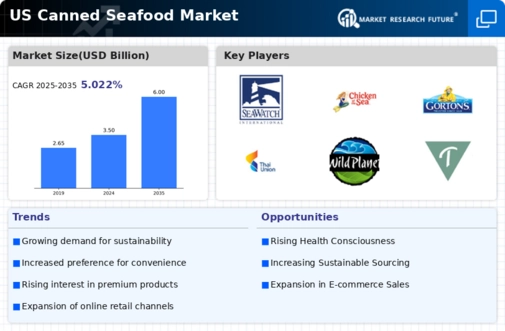Innovative Product Development
The canned seafood market is experiencing a wave of innovative product development aimed at diversifying offerings and attracting new consumers. Manufacturers are increasingly experimenting with flavors, packaging, and product formats to cater to evolving consumer preferences. For instance, the introduction of gourmet canned seafood options and unique flavor combinations is gaining traction. Market data indicates that specialty canned seafood products are projected to grow by 5% annually through 2026. This innovation is crucial for the canned seafood market, as it not only enhances consumer interest but also allows brands to differentiate themselves in a competitive landscape. By continuously evolving their product lines, companies can better meet the demands of a diverse consumer base.
Expansion of E-commerce Platforms
The canned seafood market is witnessing a transformative shift due to the expansion of e-commerce platforms. As online shopping becomes more prevalent, consumers are increasingly turning to digital channels for their grocery needs. This trend is particularly pronounced in the food sector, where online sales of canned goods have surged. Data suggests that e-commerce sales in the food and beverage category are expected to reach $100 billion by 2025. This shift presents a substantial opportunity for the canned seafood market, as brands can leverage online platforms to reach a broader audience. The convenience of home delivery and the ability to easily compare products may further drive sales, enhancing the market's growth trajectory.
Growing Interest in Sustainable Practices
The canned seafood market is increasingly influenced by a growing interest in sustainable practices among consumers. As environmental concerns gain prominence, many individuals are seeking products that align with their values regarding sustainability. Canned seafood brands that prioritize responsible sourcing and eco-friendly packaging are likely to resonate with this demographic. Recent studies indicate that approximately 60% of consumers are willing to pay a premium for sustainably sourced seafood. This trend suggests that the canned seafood market could experience growth as brands adopt sustainable practices, thereby appealing to environmentally conscious consumers. The industry's commitment to sustainability may not only enhance brand loyalty but also contribute to a positive public perception.
Rising Demand for Convenient Meal Options
The canned seafood market is experiencing a notable increase in demand for convenient meal solutions. As consumers lead busier lifestyles, the preference for ready-to-eat and easy-to-prepare food products has surged. Canned seafood, with its long shelf life and minimal preparation requirements, aligns well with this trend. According to recent data, the convenience food sector is projected to grow at a CAGR of approximately 4.5% through 2026. This growth is likely to bolster the canned seafood market, as more individuals seek quick meal options without compromising on nutrition. The industry's ability to adapt to consumer preferences for convenience is crucial, as it positions canned seafood as a viable alternative to traditional meal preparation, thereby enhancing its market presence.
Increased Awareness of Nutritional Benefits
The canned seafood market is benefiting from a growing awareness of the nutritional advantages associated with seafood consumption. Rich in omega-3 fatty acids, protein, and essential vitamins, canned seafood is increasingly recognized for its health benefits. Recent surveys indicate that nearly 70% of consumers are actively seeking healthier food options, which positions canned seafood favorably in the market. The industry's emphasis on promoting these nutritional benefits through marketing campaigns is likely to attract health-conscious consumers. Furthermore, as dietary guidelines continue to advocate for increased seafood intake, the canned seafood market may see a significant uptick in demand, particularly among those looking to enhance their diets with nutrient-dense foods.

















Leave a Comment